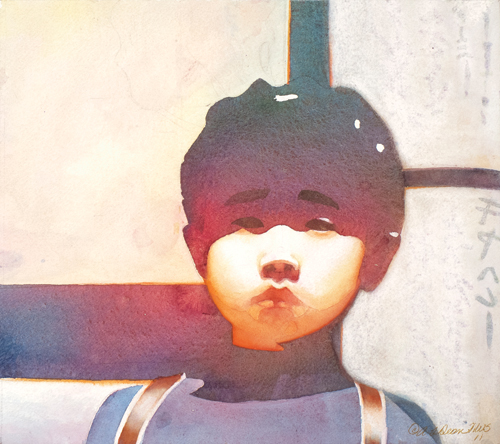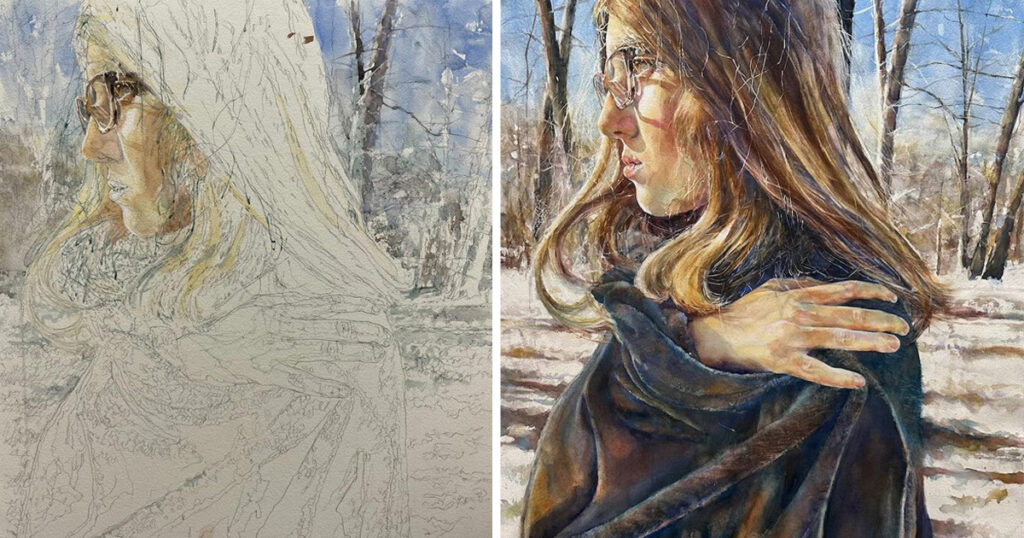Creativity Workshop: Watercolor Tips for Successful Pouring

By Amy Dean McKittrick
Because I love a challenge, I decided to experiment with watercolor techniques and try pouring diluted watercolor paint directly onto paper. I prefer a lot of color contrasts in my work and thought the technique would lend itself to my style, enabling me to create luminous darks, strong contrasts between light and shadow, and seamless color transitions.

3 watercolor tips for successful pouring
1. Keep your first attempt small and simple.
2. Use quality frisket such as Winsor & Newton’s.
3. Be patient. Let your paper dry thoroughly between pours.
Preparation and Plan
I start with a detailed sketch on Arches 260-lb. cold-pressed paper mounted on Gatorboard. I then mask all the areas I want to keep white by using a rubber nib to outline them. I fill in the areas using an inexpensive nylon craft brush dipped in warm soapy water. I go over these areas a second time with diluted frisket to fill in any air bubbles and missed spots.
Because I don’t want my paintings to be poured completely, I also mask areas to be painted with a brush, such as faces in my figurative work, and then go back into them later.
A limited palette helps to promote color harmony and prevents confusion when choosing color. This, along with a working knowledge of materials, will help you paint more instinctively.
Because different watercolors have different tinting strengths, I don’t have a paint-to-water ratio. Instead, I mix my paints in cups and then use a brush to paint swaths of color on paper until I’m satisfied with the resulting value. After pre-mixing my paints in light, medium and dark values, I put them in three sizes of plastic squeeze bottles—the lightest value in the largest bottle, the mid-value in the middle-sized bottle and the darkest in the smallest.
Pour and Paint
Here’s the process I follow for my three-step pouring technique:
POUR 1:
For the first pour, I begin with the lightest value. Thoroughly wetting the paper, I pour on the paint starting with my lightest color, yellow, and finishing with my darkest, blue, all the while tilting my board until I’m satisfied with the effect. I’m careful not to overpour, and I pour one section at a time. I let the paint dry overnight.
POUR 2:
I mask out my mid-values and repeat the pouring process with the darkest values, letting the painting dry overnight.
POUR 3:
The third pour is usually the final pour. Before this pour, I may paint sap green directly into areas where I want more depth in the shadows, such as the shaded facial features in Le Tragedie de la Guerre, and then pour over them. This often eliminates the need for another pour. Also, I often drop paint, wet-into-wet, into select sections with a brush before a pour dries. I sometimes do a fourth pour, but not very often, because I don’t want the dark areas to lose their luminous quality.
After the paint has dried completely, I peel off the frisket using a rubber eraser. This reveal is the most exciting part to me. I finish the piece by using a brush to add features and details, softening any edges with a scrubber brush as needed. I may touch up areas where too much color has come off with the frisket, but I do this carefully and only in the lightest areas.
Try This at Home
Create a painting using the poured technique and four paint colors. Send a JPEG (with a resolution of 72 dpi) to [email protected] with “Creativity Workshop” in the subject line and tell us about your process. The “editor’s choice” will receive a copy of Splash 15 (North Light Books, 2014). The entry deadline is August 15.
MORE RESOURCES FOR WATERCOLOR ARTISTS
Subscribe to Watercolor Artist magazine
Get the 2013 Watercolor Artist CD archive
Watch watercolor art workshops on demand at ArtistsNetwork.TV
Get unlimited access to over 100 art instruction ebooks
Online seminars for fine artists
Sign up for your Artists Network email newsletter & receive a FREE download





Have a technical question?
Contact UsJoin the Conversation!